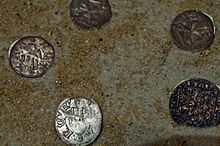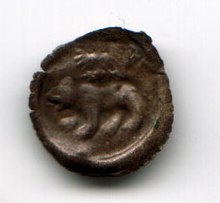 Silver trading
heller
(
Handelheller
), Hall am Kocher, 13th century
Silver trading
heller
(
Handelheller
), Hall am Kocher, 13th century
The
Heller
, abbreviation
hlr
, was a coin, originally valued at half a
pfennig
, that was issued in
Switzerland
and states of the
Holy Roman Empire
, surviving in some European countries until the 20th century.
It was first recorded in 1200 or 1208
[1]
or, according to Reiner Hausherr as early as 1189.
[2]
The
hellers
were gradually so debased that they were no long silver coins. There were 576
hellers
in a
Reichsthaler
("imperial
thaler
"). After the
Second World War
,
hellers
only survived in
Czechoslovakia
and
Hungary
.
The
heller
also existed as a silver unit of weight equal to
1
⁄
512
of a
Mark
.
Notgeld
(emergency
paper money
) was issued in
Germany
,
Austria
and
Liechtenstein
during the
interwar period
denominated in hellers.
Name
[
edit
]
The
Heller
, also called the
Haller
or
Haller
(
German:
[?h?l?]
ⓘ
), in Latin sources:
denarius hallensis
or
hallensis denarius
, took its name from the city of Hall am Kocher
[3]
(today
Schwabisch Hall
).
[4]
[5]
Silver coins stamped on both sides (
Haller Pfennige
) were called
Handelheller
because they usually depicted a hand. A distinction was made between white, red and black
hellers
.
Germany
[
edit
]
 Heller, Frankfurt, from 1428
Heller, Frankfurt, from 1428
 Hellers
,
Electorate of Hesse
, 1863
Hellers
,
Electorate of Hesse
, 1863
Overview
[
edit
]
Mints produced the coin from the beginning of the 13th century,
[6]
based on a previously produced silver pfennig (Haller Pfennig, sometimes called
Handelheller
for its depiction of a hand on the front face), but its composition deteriorated with the mixing in
copper
little by little so that it was no longer considered to be a silver coin. There were red, white and black Hellers. Beginning in the Middle Ages it became a symbol of low worth, and a common German byword is "
keinen (roten) Heller wert
", lit.: not worth a (red) Heller, or "not worth a red cent".
The term
Heller
came into wide use as a name for coins of small value throughout many of the German states up to 1873 when, after
German unification
, Bismarck's administration introduced the
Mark
and the pfennig as coinage throughout the
German Empire
.
History
[
edit
]
In
Swabia
the
Heller
originally corresponded to the
Pfennig
, so that there were 240
Heller
in a
Charlemagne pound
. However, by an imperial edict of 1385, the value of the
Heller
was halved, resulting in 8
Hellers
= 4
Pfennigs
= 1
Kreuzer
and 4
Kreuzer
= 1
Batzen
[7]
Due to the low value and the non-standard quality of these coins, it was common in the High and Late Middle Ages to weigh large amounts of
Hellers
and to transact business based on the total coin weight; this often resulted in purchase amounts in "
pound
hellers
", which did not necessarily correspond to the
Charlemagne
at 240
hellers
.
In what was then Bohemian
Upper Lusatia
, the cities
Bautzen
and
Gorlitz
had the right to mint coins. In the 15th century they coined alternately every year. The
Gorlitz Heller
(
Katterfinken
) was a coin whose silver content decreased more and more in later years.
For example, around 1490, the
House of Wettin
's silver
pfennig
currency was: 24
hellers
= 12
pfennigs
= 2 half
Schwertpfennigs
= 1
Spitzpfennig
= 1
Bartpfennig
or
Zinspfennig
. The
hellers
were hollow and called
Hohlhellers
, similar to the Thuringian
Hohlpfennigs
.
In Electoral Saxony, low-value
Besselpfennigs
circulated as "invaders". They were referred to as
Napfchenheller
in Saxon documents from 1668. In some areas of Saxony, for example in the
Ore Mountains
, they became a nuisance. The population preferred to throw the lower value
Napfchenhellers
into the
collection bag
, which significantly reduced income from the collection. This led, for example, in
Annaberg
to the introduction of special church
pfennigs
(
Kirchenpfennige
).
[8]
In the
Electorate of Hesse
, the silver
groschen
was divided into 12
hellers
, so that the
heller
was equal to the Prussian
pfennig
.
Dreiheller
were copper 1
1
⁄
2
pfennig
pieces that were minted in
Saxe-Gotha
.
With the transition to a standard imperial currency of
marks
and
pfennigs
under the Coinage Act of 9 July 1873, the
heller
disappeared like all other old currency units (except for the simple
Vereinstaler
, which circulated until 1907). Only the
last Bavarian Heller
of the former guilder standard were still valid in Bavaria for a considerable time after 1878 as
1
⁄
2
pf coins of the new
Goldmark
imperial currency.
German East Africa
[
edit
]
 A
heller
from German East-Africa
A
heller
from German East-Africa
The German
heller
was resurrected in 1904 when the government took over responsibility for the currency of
German East Africa
from the
German East Africa Company
. The
heller
was introduced as 1/100 of a
rupie
instead of the pesa, which had been a 1/64 of a rupie up to that time.
 Bills of 80 and 20 Hellers from 1920 and 1921
Bills of 80 and 20 Hellers from 1920 and 1921
In the 1920s the
Heller
currency was expanded to greater denominations in the German territories and printed bills were produced to represent their value for trade. Coins valued at
1
⁄
2
, 1, 5, 10 and 20
hellers
were minted.
Austria-Hungary
[
edit
]
In
Austria-Hungary
,
Heller
was also the term used in the Austrian half of the empire for 1/100 of the
Austro-Hungarian krone
(the other being
filler
in the Hungarian half), the currency from 1892 until after the demise (1918) of the Empire.
Czech Republic and Slovakia
[
edit
]
The term
heller
(
Czech
:
hale?
,
Slovak
:
halier
) was also used for a coin valued at 1/100 of a
koruna
(crown) in the
Czech Republic
(
Czech koruna
) and
Slovakia
(
Slovak koruna
), as well as in former
Czechoslovakia
(
Czechoslovak koruna
).
Only the currency of the Czech Republic continues to use
hellers
(
hale?e
), although they survive only as a means of calculation ? the
Czech National Bank
removed the coins themselves from circulation in 2008 and notionally replaced them with
rounding to the next koruna
.
Liechtenstein
[
edit
]
 Different
heller
notes in Liechtenstein
Different
heller
notes in Liechtenstein
In Liechtenstein, emergency money was in circulation from 1919 to 1924. The denominations were based on the
heller
.
Switzerland
[
edit
]
 Haller
, Berne, 15th century
Haller
, Berne, 15th century
 3
Haller
, Zurich, date unknown
3
Haller
, Zurich, date unknown
In the late Middle Ages, the
haller
was the lowest denomination coin in the area of the
Swiss Confederation
and corresponded to half a
pfennig
. From the 1320s, the first south German
haller
made its way to northern Switzerland, where it replaced the production of small, one-sided
pfennigs
, which were now known as
haller
.
This
haller
established itself as a basic unit in the city-state of
Zurich
and in the princely
Abbey of St. Gallen
from 1370 onwards. As the name of an increasingly devalued coin, the
haller
existed nominally until the end of the 18th century.
In culture
[
edit
]
Ein Heller und ein Batzen
is a well-known student and soldier's song by Albert von Schlippenbach (lyrics) and
Franz Kugler
(music).
The German
idiom
Das ist keinen roten Heller wert
? "that's not worth a red
heller
" ? goes back to the coin's low value and means that something is worthless. Others include
eine Schuld auf Heller und Pfennig begleichen
("to settle a debt to the last
heller
and
pfennig
" i.e. to settle a debt in full),
seinen letzten Heller verlieren
("to lose your last
heller
") and
keinen roten Heller haben
("to not have a red
heller
" i.e. penniless).
[9]
[10]
On the
A 33 motorway
north of the Wunnenberg-Haaren interchange is the
motorway services
station of
Letzter Heller
("Last Heller"). In earlier times there was an inn nearby. After the residents of the surrounding villages had done their shopping in Paderborn and returned to their villages on foot, they paused halfway at the inn and "spent their last
heller
".
[11]
See also
[
edit
]
References
[
edit
]
- ^
Helmut Kahnt:
Das große Munzlexikon von A bis Z.
H. Gietl Verlag, Regenstauf 2005, p. 188.
- ^
Reiner Hausherr (ed.):
Die Zeit der Staufer. Geschichte ? Kunst ? Kultur.
Vol. 1:
Katalog.
Wurttembergisches Landesmuseum, Stuttgart 1977, p. 158.
- ^
Escher (1881).
Schweizerische Munz- und Geldgeschichte von den altesten Zeiten bis zur Gegenwart
(in German). Dalp. p. 105.
- ^
Benedikt Zach:
Haller [Heller]
in
German
,
French
and
Italian
in the online
Historical Dictionary of Switzerland
.
- ^
Gebhard Mehring:
Schrift und Schrifttum
. Chapter III, p. 38
- ^
Revue suisse d'economie politique et de statistique
(in German). 1877. p. 214.
- ^
For further details on the relationship between the different types of coins, see the article in the
Schwabisches Worterbuch
.
- ^
Kahnt (2005), p. 309.
- ^
Fischer, Hermann (1911).
Schwabisches Worterbuch
, Vol 3. Tubingen: Laupp'schen Buchhandlung. pp. 1409-1411, "Heller".
- ^
Haller II. In: Schweizerisches Idiotikon, Band II Sp. 1130 ff.
- ^
Last Heller: How did the rest area on the A 33 get its Names?
at nw.de, 5 April 2021, retrieved 6 November 2021
Further reading
[
edit
]
|
|---|
| Late Modern period (1750?2000)
| | |
|---|
| Late Middle Ages (1250?1500)
| |
|---|
| High Middle Ages (1000?1250)
| |
|---|
| Early Middle Ages (600?1000)
| |
|---|
| Other
pfennig
related denominations
| |
|---|
| See also
| |
|---|
|